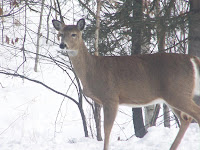Even before Richard Louv wrote the national bestseller
"Last Child in the Woods" (Algonquin) and coined the phrase "nature-deficit
disorder," groups and government entities were attempting to fill a mentorship
gap that has left a generation of kids with no one to kindle their connection
with nature and teach them the skills needed to interact with it.
 An exhaustive new study by Virginia-based Responsive
Management suggests that those youth mentoring programs can be effective in
retaining and even enhancing a child's existing interest in the outdoors, but
they're not as good at sparking an interest in kids with no previous outdoor
experience.
An exhaustive new study by Virginia-based Responsive
Management suggests that those youth mentoring programs can be effective in
retaining and even enhancing a child's existing interest in the outdoors, but
they're not as good at sparking an interest in kids with no previous outdoor
experience.
A joint project of the National Wild Turkey Federation
and Responsive Management, the 2011 study was conducted under a multi-state
conservation grant from the U.S. Fish and Wildlife Service and administered by
the Association of Fish and Wildlife Agencies. Its goal was to document levels
of interest and participation in hunting, fishing and sport shooting before and
after involvement in youth mentor programs, and to identify specific,
research-based recommendations and strategies that enhance interest in those
activities.
Nearly 900 pages, the study surveyed more than 40
hunting, shooting and fishing programs for youths and analyzed their
effectiveness in connecting kids with nature.
Mark Damian Duda, executive director of Responsive
Management, said he found some of the results surprising.
"That there are so many programs doing this across the
country -- over 400 -- came as a surprise to me," he said. "In recent years
we've seen participation in hunting and fishing generally in decline, but one
thing I found surprising was that there are so many kids in the pipeline who
want to learn these skills, if someone will show them."
The study found that participants in recruitment and
retention programs:
• Tended to more readily identify themselves "as
hunters, shooters and anglers after their involvement in the programs."
• "Came out with their interest in the activity either
intact or heightened, and their support or approval for the activity either
affirmed or strengthened."
• Increased their perception, in many cases, that
"stewardship and conservation actions are highly important."
"One of the things that struck me was how much money the
programs were generating as a result of participation," Duda said. "Some of
these people are buying $300 to $500 worth of equipment that they otherwise
might not have purchased if it weren't for their involvement in the
program."
Duda said one of the study's findings was very much
expected.
"It came as no surprise to me that these agencies and
groups are doing a really good job when it comes to these programs with very
little resources," he said. "The ratings by the kids and parents for some of
these programs were very high."
Among the nation's top-rated youth recruitment and
retention programs was Pass It On Outdoors Mentors, an offshoot of the Wichita,
Kan., Big Brothers Big Sisters program. Pass It On finds hunters and anglers
interested in passing on their love of nature and outdoors skills, and places
them with individual kids who lack that connection. Based on the ratings of
young participants, Pass It On ranked second nationwide for increasing strong
approval of hunting, second for increasing the likelihood of going hunting,
second for increasing the likelihood of going shooting, and fourth for
increasing the likelihood of going fishing.
Pass It On's Mike Christiansen said the group's success
is rooted in its connection with Big Brothers Big Sisters.
"They've got tons of kids, and they love getting outside
if someone will take them," he said. "We found that 40 percent of our kids did
not have family members previously involved in the outdoors."
The Pennsylvania Fish and Boat Commission's Family
Fishing Program was included in the study. But with a very low sample size
(researchers conducted only seven pre-program interviews and five post-program
interviews), the report noted that "statistical analyses using percentages was
not statistically valid."
One of many outdoors mentor programs active in the
Pittsburgh area, Fish and Boat's youth program dates back decades. About six
years ago the agency formalized its Family Fishing Program, which combines free
instruction in safety, natural history, knot tying, tackle use, casting and
mentored fishing, and a stipulation that children and adult family members have
to participate together.
Southwest Region outreach and education coordinator
Dennis Tubbs said statewide, thousands have been through the program.
"Locally, we're getting as many as 75 people at a
hands-on demonstration and practice," he said.
Like many recruitment and retention programs, said
Tubbs, the goal isn't simply to sell more fishing licenses.
"It's awareness, to get people to understand," he said.
"We want to get them out and have a positive experience on the water. When they
read something about the water or about nature in the paper, they'll have that
connection and be more informed, more involved."
The Fish and Boat Commission will hold a Family
Fishing Program 9 a.m.-1 p.m Sept. 3 at Raccoon Creek State Park, at the beach
near the fishing pier. To schedule a free Family Fishing Program with your
school, church, civic or social group, contact Dennis Tubbs at 1-814-442-0722,
dtubbs@state.pa.us.









